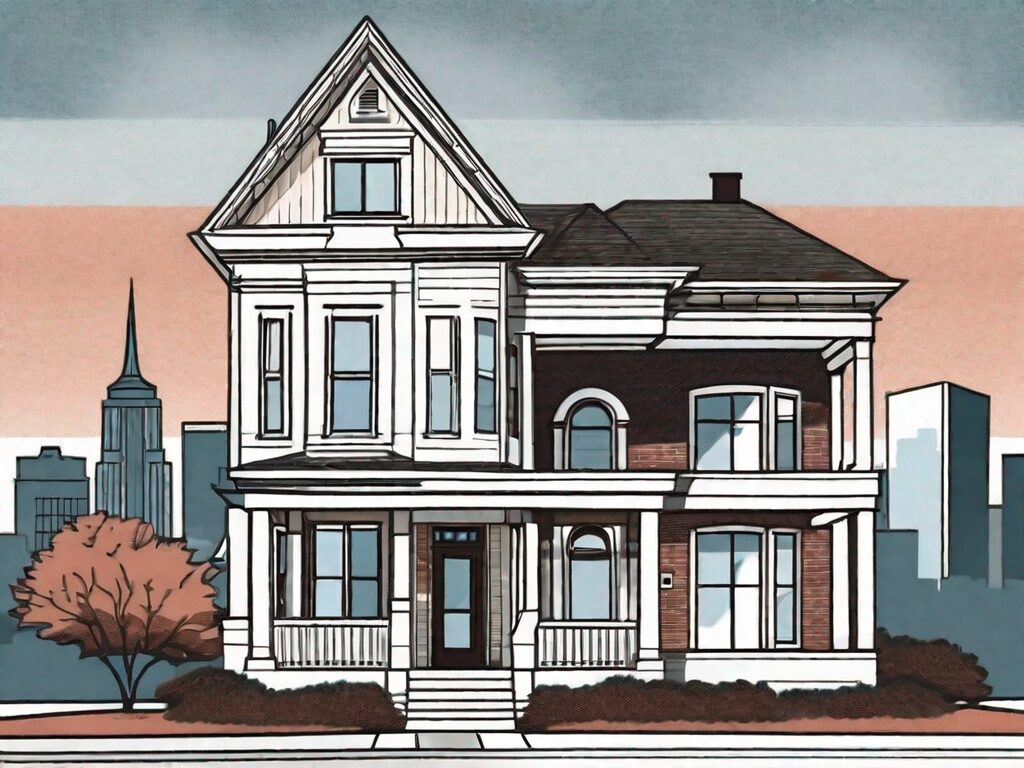
Agent A-Team or Solo Superhero? Finding the Right Real Estate Partner for Your Selling Journey in Wildwood Florida
When it comes to selling your home in Wildwood, Florida,…
January 29, 2024
House flipping has become a popular method for real estate investors to make a profit. St. Louis, Missouri, is a city that offers great potential for house flipping. In this comprehensive guide, we will explore the concept of house flipping, the profitability of flipping houses in St. Louis, and the pros and cons of this venture in this particular city. Additionally, we will provide expert tips on mastering the art of house flipping, and discuss the essential steps, considerations, and financing options involved. We will also delve into the costs of house flipping, managing finances, and estimating the time commitment required for a successful flip.
House flipping involves purchasing a property, renovating it, and then selling it for a profit within a relatively short period of time. The goal is to increase the value of the property through strategic renovations and improvements, all while minimizing costs and maximizing returns. Flippers typically look for properties that are undervalued, in need of repairs, or have strong potential for appreciation. However, it’s important to note that house flipping is not for the faint of heart. It requires careful planning, knowledge of the local market, and a solid understanding of the renovation process.
When it comes to house flipping, one of the key factors to consider is the location of the property. The old saying “location, location, location” holds true in the world of real estate. A property in a desirable neighborhood or a rapidly developing area is more likely to attract potential buyers and command a higher selling price. Flippers often research the local market extensively to identify areas with high demand and limited supply, as this can lead to a quick sale and a higher profit margin.
Another important aspect of house flipping is the renovation process. Flippers need to carefully assess the condition of the property and determine which renovations will add the most value. This involves considering factors such as the age of the property, the overall layout, and the preferences of potential buyers. Renovations can range from simple cosmetic updates, such as fresh paint and new flooring, to more extensive projects like kitchen and bathroom remodels. The key is to strike a balance between the cost of the renovations and the potential increase in property value.
It’s also worth noting that house flipping is not a guaranteed way to make money. Flippers face a number of risks and challenges along the way. For example, unexpected issues may arise during the renovation process, such as structural problems or hidden damage. Flippers also need to carefully manage their budget and timeline to ensure that they can complete the project within a reasonable timeframe and avoid excessive costs. Additionally, the real estate market can be unpredictable, and there is always a risk that the property may not sell for the desired price or within the expected timeframe.
Despite the challenges, successful house flippers can reap significant rewards. In addition to the financial gains, house flipping can also provide a sense of satisfaction and accomplishment. Seeing a neglected property transformed into a beautiful, updated home can be incredibly rewarding. Furthermore, house flipping can contribute to the revitalization of neighborhoods and communities, as renovated properties can attract new residents and improve the overall aesthetic appeal of the area.
In conclusion, house flipping is a complex process that involves purchasing, renovating, and selling properties for a profit. It requires careful planning, market research, and a solid understanding of the renovation process. While it can be challenging and risky, successful house flippers can enjoy financial rewards and a sense of accomplishment.
When it comes to house flipping, St. Louis presents a lucrative opportunity for investors. The city has a diverse real estate market, with a steady demand for renovated properties. St. Louis offers a mix of affordable neighborhoods and upscale areas, catering to a wide range of buyers.
One of the key factors contributing to the profitability of flipping houses in St. Louis is the city’s strong job market. With a thriving economy and a variety of industries, St. Louis provides a stable foundation for real estate investments. The low unemployment rate in the city further enhances the potential for a high return on investment.
Another advantage of flipping houses in St. Louis is the affordable cost of living. Compared to other major cities, the cost of housing in St. Louis is relatively low. This affordability factor attracts both first-time homebuyers and investors looking for profitable opportunities. As a result, the demand for renovated properties remains consistently high.
Furthermore, St. Louis has experienced a significant increase in population in recent years. This population growth, coupled with a surge in millennials looking to buy homes, creates a favorable environment for house flippers. The younger generation, in particular, is seeking modern, move-in ready homes, making renovated properties highly desirable.
In addition to the favorable market conditions, St. Louis offers a range of resources and support for house flippers. The city has a strong network of real estate professionals, including realtors, contractors, and property management companies, who can assist investors throughout the flipping process. These professionals have extensive knowledge of the local market and can provide valuable insights and guidance.
Moreover, St. Louis boasts a vibrant and diverse community, with a rich cultural heritage and a thriving arts scene. The city offers numerous attractions, including museums, parks, and entertainment venues, making it an appealing place to live for potential buyers. This vibrant community adds value to renovated properties, further increasing their profitability.
In conclusion, the profitability of flipping houses in St. Louis, MO is evident due to various factors. The city’s strong job market, low unemployment rate, affordable cost of living, population growth, and the surge in millennial homebuyers all contribute to the attractiveness of the real estate market. With a range of resources and a vibrant community, St. Louis presents a promising opportunity for investors looking to capitalize on the house flipping trend.
Flipping houses has become a popular investment strategy in St. Louis, offering the potential for substantial profits. However, it’s important to carefully consider the advantages and disadvantages before diving into this venture.
1. Affordable Properties: One of the major advantages of flipping houses in St. Louis is the availability of affordable properties. The city offers a range of housing options at relatively low prices, enabling investors to get a good deal on their initial purchase. This affordability factor allows flippers to potentially maximize their return on investment.
2. Strong Demand: St. Louis boasts a growing population and desirable neighborhoods, which ensures a steady demand for renovated houses. The city’s rich history, cultural attractions, and vibrant community make it an attractive place for people to settle down. As a result, there is a constant need for well-renovated properties, providing flippers with a consistent market for their projects.
3. Favorable Market Conditions: St. Louis benefits from a favorable real estate market due to its strong job market, affordable cost of living, and overall economic conditions. The city’s diverse industries and thriving business sector create a stable foundation for the housing market. This stability, coupled with the city’s affordability, makes it an ideal location for flipping houses.
1. Competition: With the popularity of house flipping, investors face stiff competition from other flippers in St. Louis. As more people recognize the potential profits in this market, the number of individuals entering the industry continues to rise. This increased competition can make it challenging to find suitable properties at reasonable prices, potentially affecting profit margins.
2. Market Volatility: Like any real estate market, St. Louis is subject to fluctuations that can impact property values and demand. Economic downturns or changes in market conditions can lead to a decrease in property prices, making it more difficult for flippers to sell their renovated homes at a desirable profit. It is crucial for investors to carefully monitor market trends and be prepared for potential volatility.
3. Renovation Challenges: The process of renovating a house can be complex and time-consuming. Flippers in St. Louis must navigate various challenges, including obtaining permits, managing contractors, and ensuring compliance with building codes. Additionally, unexpected issues may arise during the renovation process, such as structural problems or hidden damage, which can add to both the cost and timeline of the project. Successful flippers must have a strong understanding of the renovation process and be prepared to handle unexpected obstacles.
While house flipping in St. Louis offers numerous advantages, it is essential for investors to carefully weigh the pros and cons before embarking on this journey. Conducting thorough market research, developing a solid business plan, and building a reliable network of professionals can significantly increase the chances of success in this competitive industry.
House flipping can be a lucrative venture if done right. In St. Louis, there are several key considerations to keep in mind when embarking on this journey. From choosing the right location to executing high-quality repairs, here are seven expert tips to help you succeed in the art of house flipping.
When selecting a property to flip in St. Louis, it’s crucial to consider the location. Look for neighborhoods with a stable or growing real estate market, strong school districts, and accessible amenities such as shopping centers, parks, and public transportation. These factors contribute to the overall desirability of the property and can significantly impact its resale value.
Furthermore, consider the neighborhood’s demographics and target market. Are you flipping a property for families, young professionals, or retirees? Understanding the target market will help you tailor the renovations and marketing strategies to appeal to potential buyers.
Prior to purchasing a property, conducting a thorough home inspection is essential. Hire a professional inspector who can identify any hidden issues, such as plumbing or electrical problems, foundation issues, or structural defects. This will help you accurately estimate the renovation costs and avoid any surprises later on.
During the inspection, pay attention to the property’s overall condition, including the roof, HVAC system, and the presence of any pests. Addressing these issues early on will save you time and money in the long run.
The 70% rule is a common formula used by experienced house flippers. It states that an investor should aim to purchase a property for no more than 70% of its after-repair value (ARV), minus the estimated renovation costs. This rule helps ensure an adequate profit margin and protects against potential losses.
When calculating the ARV, consider factors such as recent sales prices of similar properties in the area, current market trends, and the overall demand for homes in that particular neighborhood. Accurate estimation is key to making informed decisions and maximizing your returns.
Securing financing is an integral part of house flipping. Consider options such as traditional mortgages, hard money loans, or partnerships with private investors. Evaluate each option’s interest rates, terms, and requirements to determine the best fit for your specific situation.
It’s also important to have a solid understanding of your budget and financial capabilities. Create a detailed financial plan that includes not only the purchase price and renovation costs but also holding costs, such as property taxes, insurance, and utilities, until the property is sold.
Utilize various resources, such as online listings, real estate agents, and wholesalers, to find potential properties. Conduct thorough research, visit open houses, and analyze the neighborhood’s market trends before making a decision.
Networking with other real estate professionals can also be beneficial. Attend local real estate events and join investor groups to expand your network and gain access to off-market deals. The more options you have, the better chances you’ll find the perfect house to flip.
When renovating a house for flipping, focus on making high-quality repairs that add value to the property. This may include updating the kitchen and bathrooms, improving the curb appeal, replacing outdated fixtures, and ensuring the overall functionality and aesthetics of the house.
Consider hiring skilled contractors and tradespeople who specialize in house flipping projects. Their expertise can help you achieve professional results and avoid costly mistakes. Remember, the quality of the renovations directly impacts the property’s marketability and potential resale value.
Maximize your returns by adopting cost-saving strategies when selling your flip. This includes staging the property effectively, marketing it through multiple channels, and strategically pricing it based on a comprehensive analysis of the market and the property’s features.
Staging the property allows potential buyers to envision themselves living in the space and can significantly increase its perceived value. Utilize professional staging services or learn the art of staging yourself to create an inviting and appealing atmosphere.
When it comes to marketing, leverage both traditional and digital channels. Use professional photography, create virtual tours, and list the property on popular real estate websites and social media platforms. The wider the exposure, the more potential buyers you’ll attract.
Lastly, pricing your flip strategically is crucial. Analyze the market trends, comparable sales, and the unique features of your property to determine the optimal listing price. Avoid overpricing, as it can deter potential buyers, but also be cautious of underpricing, as it may leave money on the table.
By following these expert tips and putting in the necessary effort and research, you can master the art of house flipping in St. Louis and achieve success in this exciting and potentially profitable venture.
House flipping is an exciting and potentially lucrative venture, but it requires careful financial planning to ensure success. One of the first steps in managing your finances for a successful flip is to develop a detailed budget. This budget should outline all expenses, from the initial purchase of the property to the renovation and selling costs.
When creating your budget, it’s important to consider not only the obvious expenses like materials and labor but also the hidden costs that can easily be overlooked. These hidden costs may include permits and inspections, real estate agent fees, closing costs, and even unexpected repairs that may arise during the renovation process.
Monitoring your expenditures closely is crucial to staying within budget and avoiding any financial setbacks. This can be done by keeping detailed records of all expenses and regularly comparing them to your budget. By doing so, you can identify any areas where you may be overspending and make adjustments accordingly.
Flipping houses is not a venture that can be done overnight. It requires a significant time commitment and careful planning to ensure everything goes smoothly. Before diving into a house flip, it’s essential to have a realistic understanding of the time involved.
One of the first time-consuming tasks is finding the right property. This involves researching the market, attending open houses, and working with real estate agents to identify potential opportunities. Once a property is acquired, there are inspections to be conducted, permits to be obtained, and contractors to be hired for the renovation process.
Managing the renovation itself can also be a time-consuming task. This includes overseeing the work being done, making decisions on design and materials, and ensuring everything is completed on schedule. Finally, there’s the process of selling the house, which involves marketing, staging, and negotiating with potential buyers.
By having a realistic understanding of the time commitment required, you can better plan your schedule and prevent any delays that may impact your financial goals. It’s important to remember that unexpected issues may arise during the renovation process, so it’s always a good idea to build in some buffer time to account for any unforeseen circumstances.
In conclusion, house flipping is an exciting and potentially profitable venture, but it requires careful financial management and a realistic understanding of the time commitment involved. By developing a detailed budget, monitoring your expenses closely, and estimating the time required for each step of the process, you can increase your chances of success. With the right approach and diligent planning, house flipping can be a rewarding endeavor in the St. Louis market.

If you want the Richr team to help you save thousands on your home just book a call.
 Book a call
Book a call